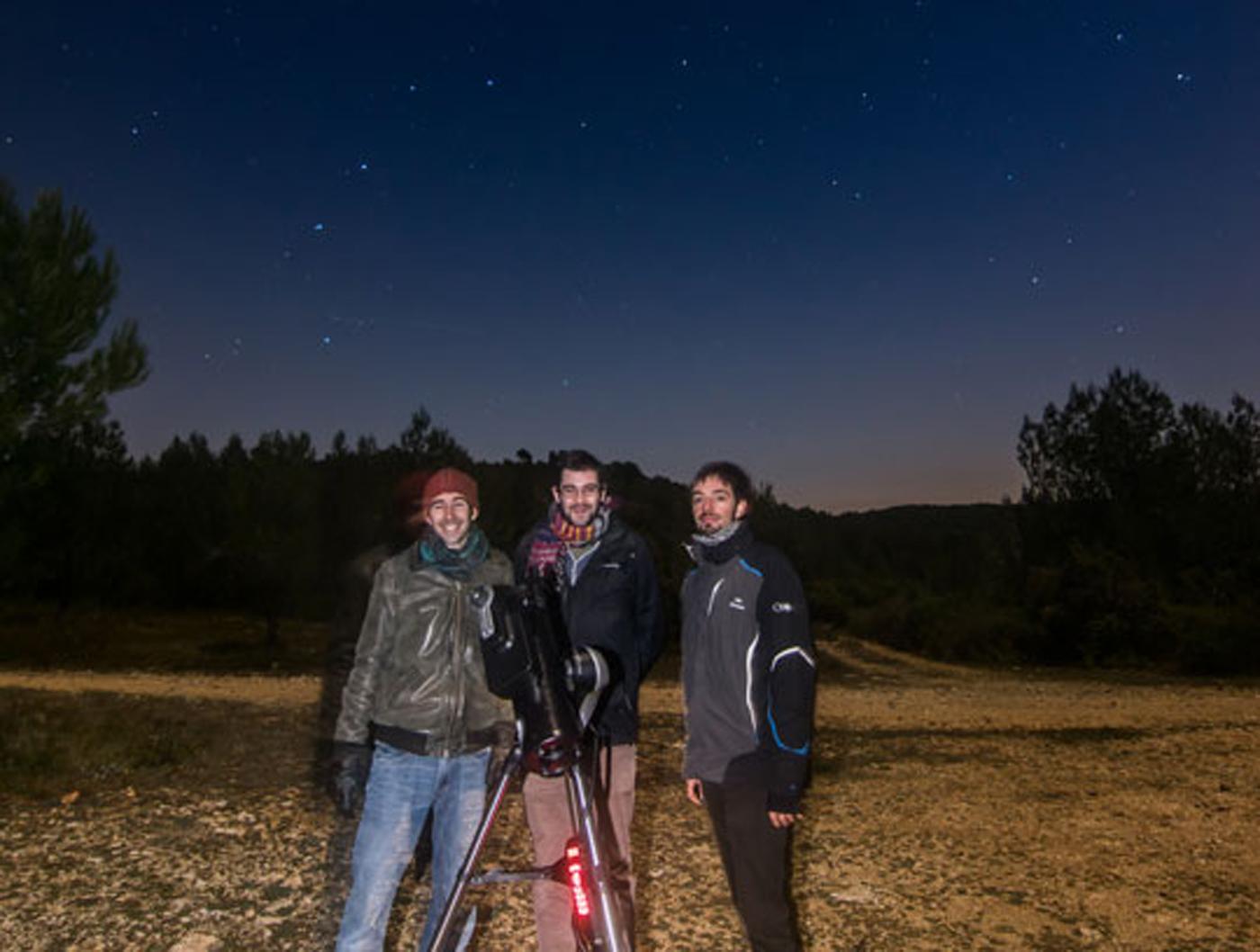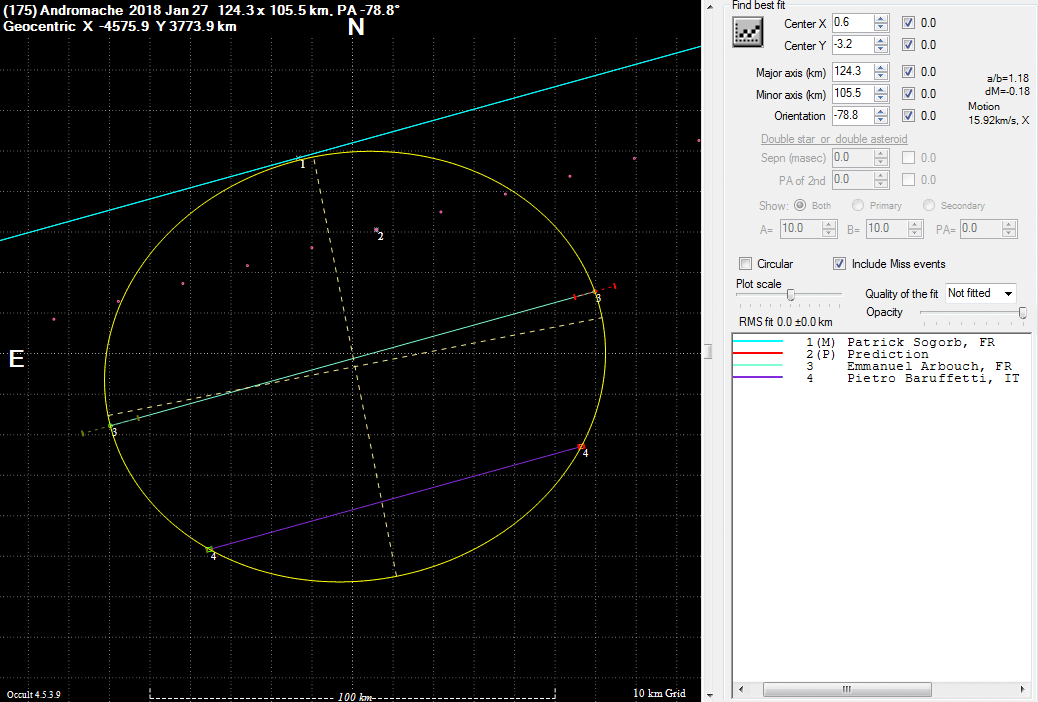Unistellar announces the first scientific result obtained with the eVscope prototype.

Unistellar is proud to announce the first real scientific result obtained with our eVscope prototype. On Jan, 27, after designing a special observing mode for this purpose, we viewed an occultation of a magnitude-11 star by the main-belt asteroid 175 Andromache . By combining our observations, which we made in Marseille, France, with others taken in France and Italy, the IOTA team was able to derive an estimated shape for the asteroid. In the future, eVscope users will be able to participate in observation campaigns just like this, helping scientists directly measure the shape and size of asteroids.
Thanks to its enhanced vision, the eVscope provides great image quality—but from day one we also knew it could also contribute to cutting-edge science in many areas, one of which is the study of asteroids.
Astronomers are very interested in the shape and the size of asteroids because this helps them understand how they formed. Unfortunately, most main-belt objects are too small to be imaged directly using a telescope, even a 8m-class one in an ideal location like Chile or Hawaii. But astronomers have discovered a trick that helps them measure the size of asteroids—one that relies on the fact that asteroids move with respect to stars and sometimes even occult a star. Because the orbits of several asteroids are well known, it’s possible to predict where and when such occultations can be seen—that is, where a shadow equal in size to the asteroid will move across the Earth (see the diagram below from IOTA). Observers located inside the shadow will see an event (or a drop in the brightness of the star).
If many observers are in the path of the shadow, astronomers can derive the size and shape of the asteroid by combining the timing of these occultations (including their beginning and end time, and the precise location of the telescope). This is also the way astronomers detect the presence of small moons around some of the largest asteroids in the main belt.
On Jan. 27, scientists predicted that asteroid (175) Andromache would occult TYC 1399-01064-1, a V=11.3 star. Centrality (i.e., the path of the shadow) was predicted to be a few-km-width line that started in south Japan, crossed into China, Kazakhstan, and Romania, and ended in Spain. Of special interest to Unistellar was the fact that the asteroid would occult the star not too far from Marseille, our headquarters city. That made us wonder if we could somehow use the eVscope to observe this event.
And so we went to work. Our R&D and Science team raced to integrate a special observing mode into the eVscope that would allow it to record both the event and the necessary metadata. Our eVscope is equipped with an IMX detector, and so has the sensitivity to record observations of an 11th-magnitude star with a short exposure time and reduced latency. And the location and time of the eVscope’s observations can be collected directly from a user’s phone. The R&D team quickly completed work on our new observing mode and traveled to Cuges-les-Pins, a small village 30 km from Marseille, which is right on the centrality path.
Thanks to cooperative weather—it was a cold but exceptionally clear night—the team quickly pointed the eVscope to the correct field of view using Automatic Field Detection, and at 18:30 UT (so in less than 5 min) started observations using a newly implemented fast-frame recording capability with an individual exposure time of 100 ms (which gives us 10 images per second). At 18:37 UT, our team noticed the disappearance of the star for about eight seconds, very close to the predicted time and duration predicted on the IOTA web site. The movie below shows what we saw in the eyepiece. Did we in fact observe the blinking of the star due to the passage of the asteroid?
Unistellar animation from SETI on Vimeo.
A posteriori analysis made using our science pipeline quickly confirmed that we had indeed seen the occultation in the eyepiece of the eVscope. We extracted the lightcurve, or flux of the occulted star w.r.t to time, which reveals an obvious drop in brightness by almost 1 mag as shown in the figure below.
After filling out a report, we submitted our first occultation measurement to IOTA and learned that two other people attempted to observe the event. Pietro Baruffetti reported an occultation of 5.76 s from Italy but Patrick Sogorb did not see the occultation from his location in the south of France. By combining these three chords (shown in the figure below) we get a good estimate of the shape and size of the asteroid (175) Andromache. Eric Frappa, who maintains the Euraster.net web site and represents IOTA in Europe, managed to fit the three chords by a slightly elongated ellipsoid with a major axis of 124 km and a minor axis of 105 km, probably close to the shape of (175) Andromache.
Surprisingly, we don’t know much about main-belt asteroid (175) Andromache. It’s been observed by the space infrared telescope IRAS, which estimated its size to be ~101 km. From a previous occultation in January 2012, astronomers concluded that it was slightly elongated (125 x 94 km). It’s classified as a C-type asteroid, which means it has a primitive composition. Our occultation brought another piece of information about this asteroid to light—information that may be used to derive its pole orientation. Because the occultation succeeded, we can use an astrometric position of the asteroid to refine its orbit and better predict its future location. And so, with one single observation, our eVscope has begun what we hope—actually, what we expect—will be the first in along and rewarding list of contributions to science and astronomy.
What’s next for Unistellar? We’ve shown that our small, portable, and smart eVscope can participate in an occultation campaign. Our team will probably observe more occultations in the future, refining our software along with our data-processing pipeline as we do it. We have a lot to learn, but we’re confident that we will include an occultation mode in the first release of our eVscope software.
This is exciting news for future users, because it proves something we have said all along—eVscopes will allow people to participate in real, cutting-edge science. Every year, an average of three to five occultations can be observed from any one location on Earth, and that number becomes much higher if people are willing to travel no more than 100 km from home. We can imagine a future when you, our eVscope users, will receive smartphone notifications of projected visible occultations. Working with IOTA and the SETI Institute, we can then organize large observing campaigns in which eVscope users record not only two or three, but hundreds of chords…the more, the merrier! This will allow astronomers to determine the shape of asteroids with a high degree of precision, including small features like surface craters or moons.
What an amazing event, and an incredible achievement, this will be for our small but mighty telescope.
Clear skies,
Franck Marchis









